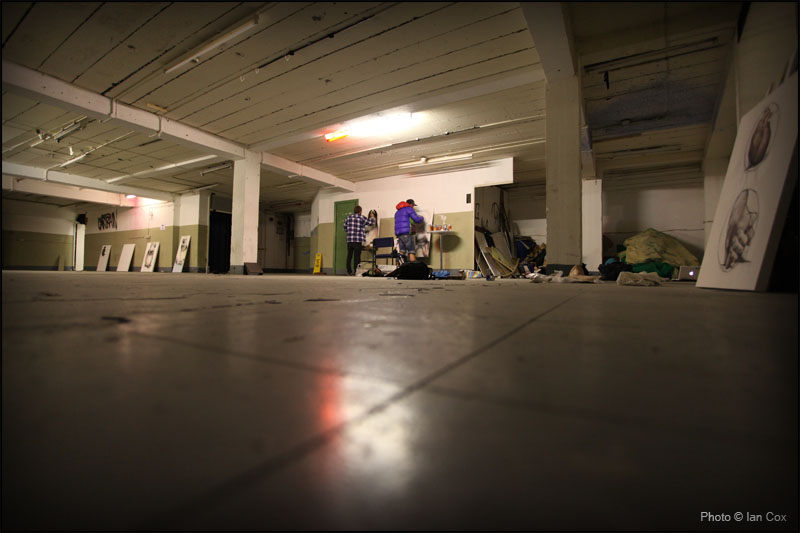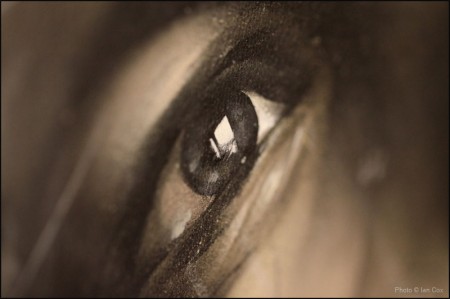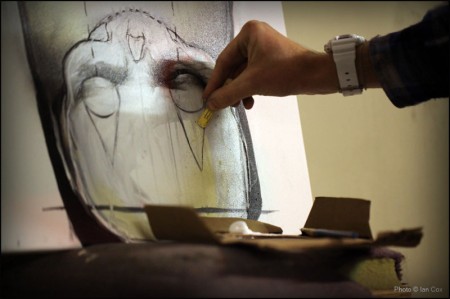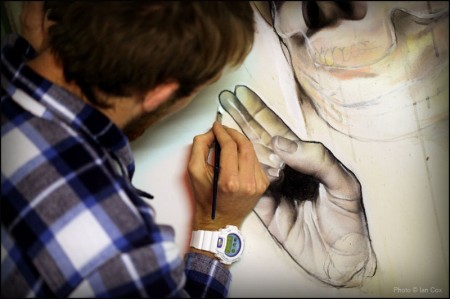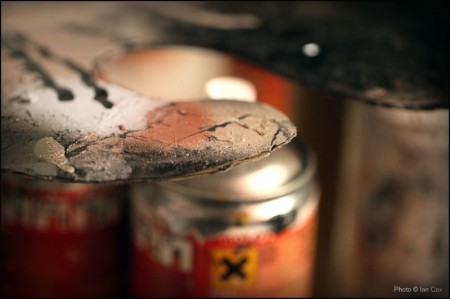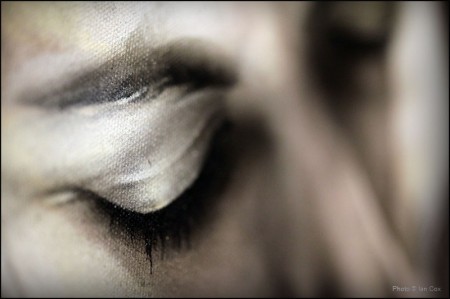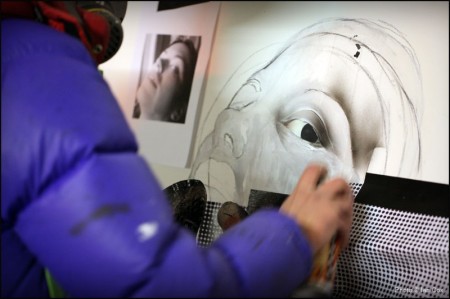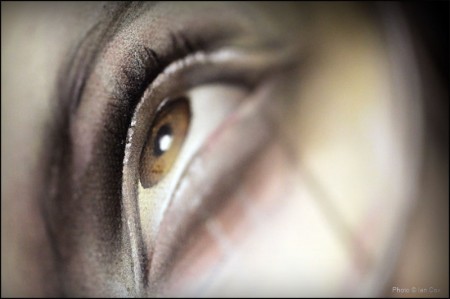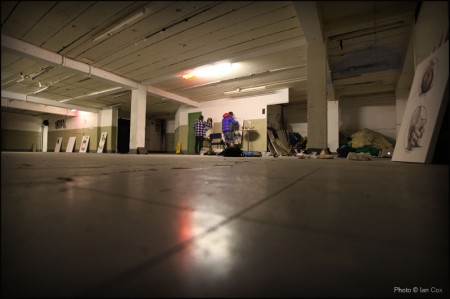Best|Ever is the collective nom de guerre of Neil Edwards and Hadley Newman. The duo have been painting together for the last years and their photo-realistic spray-can work has sent ripples of excitement through us here at AM since we first witnessed their highly technical, but equally soulful work. Since presenting a showcase of their work in London earlier this year, they are now set to roll with a full-on solo show ‘Some Anatomies of Melancholy’, opening this Thursday, November 11th at Blackall Studios.
We caught up with the crew ahead of the exhibition to put a few questions to them. Read on for our interview and some more preview pictures after the jump.
Arrested Motion (AM): We know that Best|Ever is the artistic nom de plume of Neil Edward and Hadley Newman. Can you give us a potted history of who Best|Ever are, and how your individual journeys brought you to work together?
Neil Edward (NE): I started painting graffiti in 1997, taking the usual route of painting letter forms and later painting trains. I joined the 54 crew in 2003 alongside Piro, Jae, Zadok and Slam and we started to explore photorealism in our legal productions. I had always been a real stickler for fine detail whenever I would draw or paint with brushes so it was something that came quite easy to me. By 2008, I had been producing a lot of commercial murals which required very little creative input and I had become bored and frustrated with the style of painting we had developed, and I rarely if ever painted for my own pleasure.
Out of the blue, Hadley, who I had vaguely known through the south-coast graffiti scene, got in touch with me, suggesting that we work together. We met up for a pint and went through some of his sketchbooks and it instantly lit a fire under me. He was exploring ideas which felt very personal to me, and from the off, I could see the potential in us working together. We produced our first piece together on Halloween 2008.
Hadley Newman (HN): We are both from the same town and knew each other through the graffiti scene. I liked Neil’s work and felt our styles would work well together so we started painting together and and from day one, it felt natural.
AM: And onwards from the time you came to work together, what about the last two years you have been working as a team?
NE: It’s been a bit of a blur really, we never entered into this partnership with the conscious aim of showing our work in galleries or becoming a part of that world, we kind of just fell into it. It’s been a steep learning curve, especially the last twelve months or so because we have been doing everything without the backing of a gallerist. Stylistically our work has changed so much in the first two years, and it’s only recently that I think we’ve started to become confident in what we’re producing.
HN: The last two years have been pretty good for progression, but I feel now that we are well balanced and both compliment each other really well.
AM: Where does the Best|Ever moniker originate? Is it just a bit of a brag, or is there more to it than just that?
HN: That’s all Neil’s fault.
NE: Ha ha, I hope that people will recognise that it’s not meant to be taken as a brag by looking at the content of our work. The name came about because it was something that was totally at odds to the subject matter we deal with in our paintings. We were aware of the heaviness of those topics I felt it was important to counterbalance that in our name.
AM: You each have a formal art education, but how have you found it has helped the development of your work both in terms of outdoor and indoor contexts?
NE: I don’t feel that my education helped my development as an artist with regard to technique at all, but as I’ve grown up I’ve realised the importance of contextual referencing with regards to placing your own work within the scheme of things and acknowledging your influences.
HN: That’s not strictly true for me; I lasted about three weeks in my Fine Arts degree. My degree was heavily weighted towards conceptual installation based art and you didn’t really stand a chance if you wanted to draw or paint. While I wouldn’t advise anyone to drop out, I felt as though I wasn’t gaining anything from it and I was just wasting thousands of pounds being taught how to justify bad work. I feel that instinctive painting is a skill that can’t be taught.
AM: Often, your work is described as ‘anatomical’. I think I’d consider it more ‘anthropological’ as it deals equally with emotional analysis and response as well as the study of pure form. What heralded your interest in the form of expression you use?
NE: That’s an amazing description of what we try to do… I think the need to address emotional subject matter comes purely as a response to personal experience.
HN: You’re probably right. I look for things deeper in a human body, the things you can’t really see, thoughts and feelings, blood cells, bones, nerves, angles. I include a lot of mathematical equations based around numbers and figures relevant to the subject.
AM: The faces portrayed within the work could easily be seen as masks. Is there a particular meaning behind this mechanism / metaphor? Is the depiction of the face as mask a statement on false beautification in comparison to the more visceral elements of your work?
NE: They aren’t intended to be viewed as masks. We concentrate the detail to the hands and faces because they are the main non-verbal tools humans use to communicate with one another and so we separate them from the abstracted interpretations of the body.
AM: Where do the visual references you use originate? I’ve seen that you often use photographic sources how frequently / how much of the composition is improvised?
NE: All our photographic references come from friends and family we have photographed. We used to use references from the internet but it became impossible to find the correct poses and lighting etc. which ended up compromising the finish of paintings. I think a lot of the abstract shapes that make up the torsos etc. in our figures are influenced by gestural life-drawing.
AM: How important are your sketchbooks within the evolution of your work? When sketching forms are you thinking of how the piece will translate and develop with the texture of spray-paint as the medium or does the sketch develop first as a stand-alone idea?
HN: I sketch all the time and I feel that this is really important for any artist. I sketch people, rough ideas, and these form the basis of all our paintings. I sometimes wish I could paint like I draw, it seems to be very separate sometimes.
AM: Do you bring sketches and concepts you have been working on individually to each other? I can kind of see it being like band practise when someone brings in a riff and the band works out the rest of the jam together….
NE: All the concepts and initial sketches come individually to begin with, and usually it will only begin to develop between us once work on the canvas or wall has begun.
AM: The spray-can is of course the main tool of your trade. Why the hyper-realism with spray cans? Have you considered using brushes and other tools within the composition of your work?
NE: Good question, I ask myself that almost daily… I love the speed at which you can paint using spray cans, and I still love the challenge of painting as detailed and as small as my skills will allow us using such an unpredictable tool. We have always used a variety of media in our work on walls as well as canvas, and in recent months, we have started to use oil or acrylic for fine detail more frequently in our work.
HN: Using brushes has opened up new possibilities with regards to composition and I feel its a big step in the right direction.
AM: Can you describe some of the methods and adapted tools you use to attain the hyper-reality within the work? Was it an entirely self taught learning process for each of you?
NE: For the most part it was self taught yeah… I’d learned using cut-backs (layering up the paint to achieve a much thinner line than would be possible with a nozzle), but when Hadley and I started working together it required the photorealism to become much smaller which made this technique impossible. Our good friend BUSK showed me how to cut a fence curve, which is an ‘S’ shape cut from card which enables you to perform cut-backs on a much smaller scale and mask detailed areas of from overspray. It’s an essential tool that really changed the way I paint.
HN: What he said.
AM: Are you still involved in graffiti writing either individually or part of a crew?
NE: My days of illegal graffiti are probably behind me now, unless I’m three sheets to the wind or in a foreign land.
HN: I can’t even pay off the fines I have now and plus I don’t think I would do it for the same reasons anymore.
AM: You are making some exciting work right now, but have you considered where you will be in five years time? Do you see yourselves still working as a partnership or pursuing your own individual paths?
HN: I think so. I think we progress twice as fast together but you never know what the future has for you.
NE: Depending on how successful we become, Hadley will have probably died in a car accident before then.
AM: Tell us a little about this new body of work produced for the ‘Some Anatomies of Melancholy’ solo show – I understand you are transitioning to 3D mediums as well as canvas and installation pieces…?
HN: Sometimes, I’ve found it hard to get ideas across in 2D so it’s been really interesting to attempt to interpret those ideas into 3D.
NE: For the first time, we both feel that our work has refined itself to a point we’re both truly happy with it. Because we have put the show on purely off our own backs, we’ve been producing the work we want to make without the stresses of whether it will sell or not.
AM: What gives you the biggest buzz – producing a body of work for a show that will be preserved in people’s homes for years to come or the thrill of ephemeral and ‘live’ painting outdoors?
HN: I like both. I love it when someone really understands a painting and connects with it.
NE: They’re such different disciplines… for me painting large scale in a public place is unbeatable because you are held by far fewer restraints both in subject matter and scale.
AM: Finally, who wears the pants in the Best|Ever relationship – who’s the bitch, and who’s the butch?
BE: Neither of us wear pants.
AM: Ha-ha! Thanks for taking the time to answer our questions guys. AM wishes you the best of luck with your first full-on solo show!
BE: Thank you and we hope you enjoy it.



